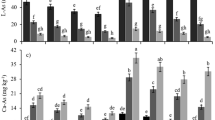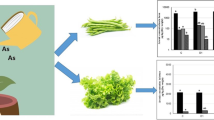Abstract
Arsenic occurs in the earth's crust in various chemical forms as a result of both natural and anthropogenic sources. Soil chemical extractions may help understand As availability, as well as the possibility of As entry into the food chain. Phytoextraction has been proposed as a technology for remediation of As-contaminated soils. The study was carried out to assess the bioavailability of As by extractants and to compare the performance of castor bean and sunflower for As removal from soils. Two soils were contaminated with Na2HAsO4.7H2O adding 35 and 150 mg As dm−3 soil. Arsenic availability was assessed using the following extractants: tri-distilled water, ammonium sulfate, ammonium phosphate, ammonium oxalate + oxalic acid, organic acids mixture, Mehlich-1, and United States Environmental Protection Agency 3051. The roots and shoots of 35-day-old plants were collected and dry matter yield as well as As concentration were determined. The accumulation of As in shoot was also calculated in order to evaluate the plants potential for As phytoextraction. The extractants tested were efficient to assess the concentration of available As in soil. Addition of As to the soils did not cause severe toxicity in plants, although the dose 150 mg As dm−3 soil decreased shoot and root yield in both species. Castor bean was less sensitive to As than sunflower, but none of the species had hyperaccumulation characteristics. These species can be used for revegetation of areas contaminated with As up to safe limit of 150 mg As dm−3 soil, as proposed by CONAMA for industrial areas in Brazil.


Similar content being viewed by others
References
Araújo, J. C. T., & Nascimento, C. W. A. (2005). Fracionamento e disponibilidade de zinco por diferentes extratores em solos incubados com lodo de esgoto. Revista Brasileira de Ciência do Solo, 29, 977–985.
ATSDR. (2007). CERCLA Priority List of Hazardous Substances. Agency for Toxic Substances and Disease Control. http://www.atsdr.cdc.gov/cercla/07list.html. Accessed 25 February 2009.
Baird, C. (2002). Química ambiental. 2.ed. Porto Alegre: Bookman, 621p.
Barra, C. M., Santelli, R. E., Abrão, J. J., & Guardia, M. L. (2000). Especiação de arsênio: uma revisão. Química Nova, 23, 58–70.
Burló, F., Guijarro, I., Carbonell-Barrachina, A. A., Vlaero, D., & Martínez-Sánchez, F. (1999). Arsenic species: effects on and accumulation by tomato plants. Journal of Agricultural and Food Chemistry, 47, 1247–1253.
Campos, M. L., Guilherme, L. R. G., Lopes, R. S., Antunes, A. S., Marques, J. J. G. S. M., & Curi, N. (2007). Teor e capacidade máxima de adsorção de arsênio em Latossolos brasileiros. Revista Brasileira de Ciência do Solo, 31, 1311–1318.
Carbonell, A. A., Aarabi, M. A., Delaune, R. D., Gambrell, R. P., & Patrick Junior, W. H. (1998). Arsenic in wetland vegetation: availability, phytotoxicity, uptake and effects on plant growth and nutrition. Science of the Total Environmental, 217, 189–199.
Conselho Nacional do Meio Ambiente – CONAMA. (2009). Resolução N° 420, de 28 de dezembro de 2009. “Dispõe sobre critérios e valores orientadores de qualidade do solo quanto à presença de substâncias químicas e estabelece diretrizes para o gerenciamento ambiental de áreas contaminadas por essas substâncias em decorrência de atividades antrópicas”. Diário Oficial da República Federativa do Brasil, Brasília, DF, nº 249, de 30/12/2009, p. 81–84. http://www.mma.gov.br/port/conama/legiano1.cfm?codlegitipo=3&ano=2009. Accessed 10 May 2010.
Cunha, K. P. V., Nascimento, C. W. A., Accioly, A. M. A., Pimentel, R. M. M., & Silva, A. J. (2008). Disponibilidade, acúmulo e toxicidade de cádmio e zinco em milho (Zea mays L.) cultivado em solo contaminado. Revista Brasileira de Ciência do Solo, 32, 1319–1328.
Day, P. R. (1965). Particle fractionation and particle-size analysis. In C. A. BLACK (Ed.), Methods of soil analysis (pp. 545–566). Madison: American Society of Agronomy.
De Filipo, B.V. & Ribeiro, A.C. (1997). Análise química do solo. Metodologia. 2.ed. Viçosa. Universidade Federal de Viçosa, 26p.
Dias, F. F., Allen, H. E., Guimarães, J. R., Taddei, M. H. T., Nascimento, M. R., & Guilherme, J. R. G. (2009). Environmental behavior of arsenic(III) and (V) in soils. Journal of Environmental Monitoring, 11, 1412–1420.
Empresa Brasileira de Pesquisa Agropecuária – EMBRAPA (1999). Centro Nacional de Pesquisa de Solos. Manual de análises químicas de solos, plantas e fertilizantes. Brasília, DF: Embrapa Comunicação para Transferência de Tecnologia, 370 p.
Fitz, W. J., & Wenzel, W. W. (2002). Arsenic transformations in soil-rhizosphere-plant system: fundamentals and potential application to phytoremediation. Journal of Biotechnology, 99, 259–278.
Gonzaga, M. I. S., Santos, J. A. G., & Ma, L. Q. (2008). Phytoextraction by arsenic hyperaccumulator Pteris vittata L. from six arsenic-contaminated soils: Repeated harvests and arsenic redistribution. Environmental Pollution, 154, 212–218.
Habuda-Stanic, M., Kalajdzic, B., Kules, M., & Velic, N. (2008). Arsenite and arsenate sorption by hydrous ferric oxide/polymeric material. Desalination, 229, 1–9.
Lee, J. S., Lee, S. W., Chon, H. T., & Kim, K. W. (2008). Evaluation of human exposure to arsenic due to rice ingestion in the vicinity of abandoned Myungbong Au-Ag mine site, Korea. Journal of Geochemical Exploration, 96, 231–235.
Liu, Y., Wang, H. B., Wong, M. H., & Ye, Z. H. (2009). The role of arsenate reductase and superoxide dismutase in As accumulation in four Pteris species. Environment International, 35, 491–495.
McBride, M. B. (1994). Environmental chemistry of soils (p. 406p). New York: Oxford University.
Nascimento, C. W. A., & Xing, B. (2006). Phytoextraction: a review on enhanced metal availability and plant accumulation. Scientia Agricola, 63, 299–311.
Nascimento, C. W. A., Fontes, R. L. F., Neves, J. C. L., & Melício, A. C. F. C. (2002). Fracionamento, dessorção e extração química de zinco em Latossolos. Revista Brasileira de Ciência do Solo, 26, 599–606.
Pires, A. M. M., Mattiazzo, M. E., & Berton, R. S. (2004). Ácidos orgânicos como extratores de metais pesados fitodisponíveis em solos tratados com lodo de esgoto. Pesquisa Agropecuária Brasileira, 39, 671–676.
Silva, S. R., Procópio, S. O., Queiroz, T. F. N., & Dias, L. E. (2004). Caracterização de rejeito de mineração de ouro para avaliação de solubilização de metais pesados e arsênio e revegetação local. Revista Brasileira de Ciência do Solo, 28, 189–197.
Smith, E., Naidu, R., & Alston, A. M. (1998). Arsenic in the soil environment: a review. Advances in Agronomy, 64, 149–195.
Tu, C., & Ma, L. Q. (2002). Effects of arsenic concentrations and forms on arsenic uptake by the hyperaccumulator ladder brake. Journal of Environmental Quality, 31, 641–647.
Tu, C., & Ma, L. Q. (2003). Interactive effects of pH, arsenic and phosphorus on uptake of As and P and growth of the arsenic hyperaccumulator Pteris vittata L. under hydroponic conditions. Environmental and Experimental Botany, 50, 243–251.
USEPA - UNITED STATES ENVIRONMENTAL PROTECTION AGENCY. (1995). Test methods for evaluating soil waste, physical/chemical methods SW-846. 3.ed. Washington, DC,. http://www.epa.gov/SW-846/3051a.pdf. Accessed 10 April 2008.
Van Raij, B., Cantarella, H., Quaggio, J. A., Ferreira, H. E., Lopes, A. S., & Bataglia, O. C. (1987). Análise química do solo para fins de fertilidade. Fundação Cargill: Campinas. 170p.
Wang, S., & Mulligan, C. N. (2006). Natural attenuation processes for remediation of arsenic contaminated soils and groundwater. Journal of Hazardous Materials, 138, 459–470.
Wang, J., Zhao, F. J., Meharg, A. A., Raab, A., Feldmann, J., & McGrath, S. P. (2002). Mechanisms of arsenic hyperaccumulation in Pteris vittata. Uptake kinetics, interactions with phosphate and arsenic speciation. Plant Physiology, 130, 1552–1561.
Wenzel, W. W., Kirchbaumer, N., Prohaska, T., Stingeder, G., Lombi, E., & Adriano, D. C. (2001). Arsenic fractionation in soils using an improved sequential extraction procedure. Analytica Chimica Acta, 436, 309–323.
Wenzel, W. W., Brandstetter, A., Wutte, H., Lombi, E., Prohaska, T., Stingeder, G., et al. (2002). Arsenic in field-collected soil solution and extracts of contaminated soils and its implication to soil standards. Journal Plant Nutrition and Soil Science, 165, 221–228.
Acknowledgments
The authors are grateful to CNPq for providing scholarships to the authors.
Author information
Authors and Affiliations
Corresponding author
Rights and permissions
About this article
Cite this article
Melo, É.E.C., Guilherme, L.R.G., Nascimento, C.W.A. et al. Availability and Accumulation of Arsenic in Oilseeds Grown in Contaminated Soils. Water Air Soil Pollut 223, 233–240 (2012). https://doi.org/10.1007/s11270-011-0853-2
Received:
Accepted:
Published:
Issue Date:
DOI: https://doi.org/10.1007/s11270-011-0853-2




